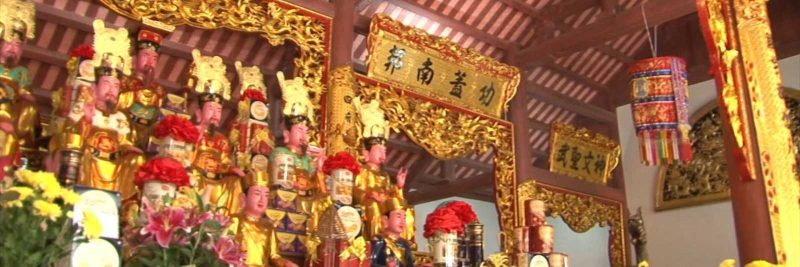Gia Temple in Thai Nguyen is one of the most famous temples in Thai Nguyen. Gia Temple worships Phu Dong Thien Vuong (Saint Giong) and Man Dien Quoc Vuong. Thai Nguyen farmers followed Thanh Giong to fight the An invaders. The temple was built a long time ago on the ancient land of Dong Cao commune, Pho Yen.

Gia temple has existed for a long time, in Cam La village of Tieu Le canton, now in Dong Cao commune, Pho Yen district; This is the place to worship Saint Giong, (Phu Dong Thien Vuong) and Manh Dien King – a patriotic local who has fought against the An invaders to save the country since the reign of King Hung VI.
According to legend, once Mr. Giong was chasing the An invaders, when he arrived at this place, the soldiers were tired, it was dark again, the trees were thick and the path was unclear. A local resident knew about the story, he brought all the food and food from his family and mobilized the villagers to help Mr. Giong’s army rest and recuperate. At the same time, he mobilized young men in the village to ask to join Giong’s army to fight the enemy. When the war was over and the country was at peace, the king named Giong as Phu Dong Thien Vuong and the patriotic farmer Manh Dien King, for the local people to set up temples to worship him. Since then, local people have built a small temple made of wood with thatched roof to worship.
In the Le Dynasty, when the national culture entered a stage of brilliant development, Gia Temple was built on a large and beautiful scale. Experiencing ups and downs in history, Gia Temple has been repaired many times, but still retains its original architecture. The temple is not only a place where locals as well as tourists from all over the world show their spiritual life, but it also shows the quintessence of the nation’s architecture. The temple area has two buildings: The front house is 5 compartments wide, for incense, worshiping objects and a place of worship during festivals. The harem house is 3 compartments wide at the back: The middle room has a high floor to worship the statue of Saint Giong, one side worships Manh Dien King and the other side worships Tho Dia Long Vuong, the god who protects and helps the villagers. The two sides of the harem door have a couple of parallel sentences in Chinese: Sac Phong, Sword, Ma Luu Ky Su / Nam Quoc Son Ha poison mutant. Around the temple, there are many big shade trees, especially 3 banyan trees, including 2 old trees, the root circumference is about 8m.
Temple Gia has 2 festivals every year. The first time on January 5-6 is the spring opening festival; 2nd time on 9/4 lunar calendar.
Not only valuable in terms of architecture, Gia temple is also the place where a great historical event of Pho Yen district took place. On August 22, 1945, at this temple, a meeting of key cadres was held to establish the first provisional revolutionary government of the district, contributing to the August 1945 revolutionary uprising of Thai province. Original. With such architectural value and historical significance, Gia Temple has been ranked as a historical-art relic in Decision No. 2774/QD-UB dated November 12, 2004 of the People’s Committee of Thai Nguyen province./ .
Source: Collected internet.